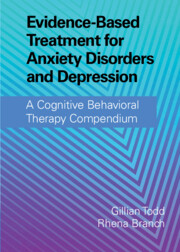 Evidence-Based Treatment for Anxiety Disorders and Depression
Evidence-Based Treatment for Anxiety Disorders and Depression from Part Five - Complexity and Comorbidity in Anxiety Disorders and Depression:
Published online by Cambridge University Press: 06 January 2022
Anxiety disorders and depression are the most prevalent mental disorders, and although psychological interventions (particularly CBT) have been shown to be effective, treatment response is often suboptimal, given that, in many cases, patients have complex presentations and frequent comorbidities. Especially in such cases, a good case formulation is essential. Case formulation derives from the initial assessment and guides intervention by conceptualizing the presenting symptoms, the underlying etiological mechanisms, and their origin. A good conceptualization should successfully inform treatment and should be evidence-based, combining research data with personalized features of each case. According to the level of analysis, we can distinguish between case, diagnosis/presenting problem formulation, and symptom level/specific problem formulation. For complex and comorbid depression and anxiety disorders, we should include additional elements and also select the most appropriate conceptualization model for our particular case.
To save this book to your Kindle, first ensure no-reply@cambridge.org is added to your Approved Personal Document E-mail List under your Personal Document Settings on the Manage Your Content and Devices page of your Amazon account. Then enter the ‘name’ part of your Kindle email address below. Find out more about saving to your Kindle.
Note you can select to save to either the @free.kindle.com or @kindle.com variations. ‘@free.kindle.com’ emails are free but can only be saved to your device when it is connected to wi-fi. ‘@kindle.com’ emails can be delivered even when you are not connected to wi-fi, but note that service fees apply.
Find out more about the Kindle Personal Document Service.
To save content items to your account, please confirm that you agree to abide by our usage policies. If this is the first time you use this feature, you will be asked to authorise Cambridge Core to connect with your account. Find out more about saving content to Dropbox.
To save content items to your account, please confirm that you agree to abide by our usage policies. If this is the first time you use this feature, you will be asked to authorise Cambridge Core to connect with your account. Find out more about saving content to Google Drive.